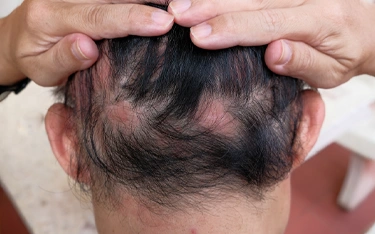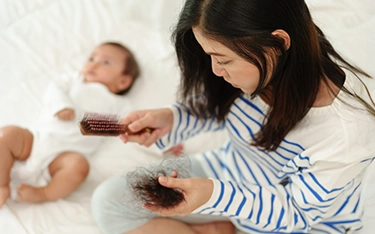Cicatricial alopecia, also known as scarring alopecia, is a rare but serious form of hair loss that results in permanent damage to the hair follicles. Unlike common types of hair loss, such as androgenetic alopecia, cicatricial alopecia destroys the follicles and replaces them with scar tissue, making regrowth impossible.
At Dr Batra’s® UAE, we understand how emotionally and physically distressing this condition can be. Our holistic approach integrates homeopathy, advanced diagnostics, and individualized care to manage and control scarring alopecia effectively.
Understanding Cicatricial Alopecia
Cicatricial alopecia occurs when inflammation or external injury causes irreversible damage to hair follicles. The body’s immune response mistakenly targets the follicles, resulting in inflammation that leads to scarring. Once the follicle is destroyed and replaced by fibrous tissue, hair can no longer grow in that area.
The key issue with cicatricial alopecia is that it often progresses silently, causing damage beneath the scalp's surface before visible symptoms appear. Without early intervention, the hair loss can become permanent.
Types of Cicatricial Alopecia
Primary Cicatricial Alopecia
In primary cicatricial alopecia, the immune system directly attacks the hair follicles. This category includes conditions like lichen planopilaris and frontal fibrosing alopecia. These disorders often require medical evaluation and a tailored treatment approach.
Secondary Cicatricial Alopecia
Secondary scarring alopecia results from external factors such as burns, infections, or radiation therapy. In these cases, hair follicle damage is not caused by an internal immune attack but by environmental or physical trauma.
Central Centrifugal Cicatricial Alopecia (CCCA)
Central centrifugal cicatricial alopecia is a common form of scarring alopecia, particularly among African American women. It typically starts at the crown and spreads outward in a circular pattern. The exact cause is unclear, but it is believed to be linked to genetics, chemical hair treatments, and chronic traction from certain hairstyles
What Causes Scarring Alopecia?
Cicatricial Alopecia Causes
Several underlying factors can contribute to cicatricial alopecia:
- Autoimmune Disorders: Conditions like lupus and lichen planus can trigger an immune response that damages hair follicles.
- Bacterial, Fungal, and Viral Infections:Infections of the scalp can lead to inflammation and eventual scarring.
- Genetic Predisposition:Some people may be more prone to developing scarring alopecia due to inherited factors.
- Inflammatory Scalp Conditions: Chronic inflammation due to conditions such as psoriasis or dermatitis may contribute to follicular damage.
- Trauma, Burns, or Radiation Exposur: Physical damage to the scalp can destroy follicles and lead to scar tissue formation.
Symptoms and Diagnosis of Cicatricial Alopecia
Common Symptoms
Identifying the early signs of scarring alopecia is crucial for preventing further hair loss. Symptoms may include:
- Itching, burning, or tenderness of the scalp
- Redness and visible inflammation
- Development of shiny, smooth patches of baldness
- Hair loss that spreads gradually and does not regrow
A thorough scalp examination, dermoscopy, and sometimes a biopsy are often needed to confirm the diagnosis.
Scarring Alopecia Natural Remedies & Home Care
Natural Remedies to Manage Symptoms
While cicatricial alopecia treatment often requires medical care, some natural remedies can help soothe symptoms and reduce inflammation:
- Essential Oils: Oils like rosemary, peppermint, and tea tree have antimicrobial and anti-inflammatory properties that may support scalp health.
- Aloe Vera: Known for its soothing properties, aloe vera can help reduce irritation and promote healing.
- Scalp Massage: Gentle massage can improve blood flow and reduce scalp tension.





